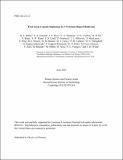| dc.contributor.author | Baker, K.L. | en_US |
| dc.contributor.author | Amendt, P.A. | en_US |
| dc.contributor.author | Ross, J.S. | en_US |
| dc.contributor.author | Smalyuk, V.A. | en_US |
| dc.contributor.author | Landen, O.L. | en_US |
| dc.contributor.author | Ho, D.D. | en_US |
| dc.contributor.author | Khan, S. | en_US |
| dc.contributor.author | Haan, S.W. | en_US |
| dc.contributor.author | Lindl, J.D. | en_US |
| dc.contributor.author | Mariscal, D. | en_US |
| dc.contributor.author | Milovich, J.L. | en_US |
| dc.contributor.author | MacLaren, S. | en_US |
| dc.contributor.author | Ping, Y. | en_US |
| dc.contributor.author | Strozzi, D.J. | en_US |
| dc.contributor.author | Bionta, R.M. | en_US |
| dc.contributor.author | Casey, D.T. | en_US |
| dc.contributor.author | Celliers, P.M. | en_US |
| dc.contributor.author | Fittinghoff, D.N. | en_US |
| dc.contributor.author | Geppert-Kleinrath, H. | en_US |
| dc.contributor.author | Geppert-Kleinrath, V. | en_US |
| dc.contributor.author | Hahn, K.D. | en_US |
| dc.contributor.author | Gatu Johnson, Maria | en_US |
| dc.contributor.author | Kim, Y. | en_US |
| dc.contributor.author | Meaney, K. | en_US |
| dc.contributor.author | Millot, M. | en_US |
| dc.contributor.author | Nora, R. | en_US |
| dc.contributor.author | Volegov, P.L. | en_US |
| dc.contributor.author | Wilde, C.H. | en_US |
| dc.date.accessioned | 2025-03-21T20:21:09Z | |
| dc.date.available | 2025-03-21T20:21:09Z | |
| dc.date.issued | 2023-06 | |
| dc.identifier | 23ja012 | |
| dc.identifier.uri | https://hdl.handle.net/1721.1/158703 | |
| dc.description | Submitted for publication in Physics of Plasmas | |
| dc.description.abstract | We report on the first indirect-drive implosions driven by a dual conical frustum-shaped hohlraum denoted “frustraum” and the experimental tuning campaigns leading up to two layered implosions. The campaign utilized 1.2 mm and 1.4 mm inner radius HDC capsules and represented the largest HDC capsules to be imploded on the National Ignition Facility via indirect drive. Several techniques were successfully implemented to control the mode 2 symmetry of the implosions including changing the wall angle of the frustraum which is not possible with cylindrical hohlraums. A mode 4 feature was observed and its implications for hot spot mix discussed. Two layered implosions were conducted with 1.2 mm inner radius capsules, the latter of which achieved the highest layered capsule absorbed energy on the NIF using only 1.74 MJ of laser energy. The layered implosion results suggest that increasing capsule absorbed energy by itself is insufficient, and that further reducing coast time (time between end of laser pulse and bang time) to the 1 ns level is warranted to improve areal density, hot spot temperature and alpha heating and yield amplification. | |
| dc.publisher | AIP | en_US |
| dc.relation.isversionof | doi.org/10.1063/5.0163396 | |
| dc.source | Plasma Science and Fusion Center | en_US |
| dc.title | First large capsule implosions in a frustum-shaped hohlraum | en_US |
| dc.type | Article | en_US |
| dc.contributor.department | Massachusetts Institute of Technology. Plasma Science and Fusion Center | |
| dc.relation.journal | Physics of Plasmas | |
